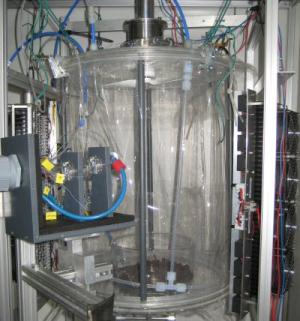
Eutrophication harms the environment in many ways. Unexpectedly, nitrogen fertilizer may also be positive for the environment. And even acidic soils, promoting the destruction of forests, can have a positive effect.
Researchers from the Biogeochemistry Department at the Max Planck Institute for Chemistry in Mainz found out that nitrogen fertilizer indirectly strengthens the self-cleaning capacity of the atmosphere. Their study shows that nitrous acid is formed in fertilized soil and released to the atmosphere, whereby the amount increases with increasing soil acidity. In the air, nitrous acid leads to the formation of hydroxyl radicals oxidizing pollutants that then can be washed out. Previously, this nitrogen-effect has not been taken into account by geoscientists.
The gap has now been closed by the Max Planck researchers.
Our air partly cleans itself as pollutants are being oxidized by hydroxyl radicals and washed out by rain. Now, researchers at the Max Planck Institute in Mainz and colleagues in Beijing have discovered the origin of a bulk part of the nitrous acid that is acting beside ozone as a source of hydroxyl radicals. According to their studies, large quantities of the acid are released into the atmosphere from soil. In nitrogen-rich soils the acid is formed from nitrite ions produced through microbiological transformations of ammonium and nitrate ions. The more acidic the soil is and the more nitrite it contains, the more nitrous acid is released. Through this pathway some of the nitrogen in fertilized soil escapes into the air.
In the latest issue of the journal Science, the Mainz researchers describe how they demonstrated the existence of this previously unnoticed pathway in the nitrogen cycle. They measured the concentration of HONO - a chemical term for gaseous nitrous acid - that escaped from a defined volume of arable soil. They added nitrite to a soil sample and varied its water content. The quantity of released HONO closely matched the researchers' estimates based on acid/base and solubility equilibria. Based on these findings they can also explain why previous studies had measured high levels of HONO in the air above fertilized agricultural soil.
The source of the high concentrations of HONO observed in the lower atmosphere had long been a mystery. "Soil is a complex system involving interactions between countless chemicals and biological organisms," says Hang Su, the lead author of the paper. "Before us, no one seems to have investigated the soil-atmosphere exchange of nitrous acid".
The fact that soil emits HONO is not just locally, but also globally significant for air quality and the nitrogen cycle. "Next, we plan to work across disciplines with soil and climate researchers to quantify the effect in different types of soil and under different environmental conditions", adds research group leader Ulrich Pöschl. The findings will then be incorporated into a global model.
The Max Planck researchers suspect that soil-based HONO emissions could strongly increase especially in developing countries due to more extensive fertilization, soil acidification, and climate-related rise in temperature. This is expected to produce more hydroxyl radicals, which increase the oxidizing power of the air.
About the Max Planck Institute for Chemistry
Around 260 people work at the Max Planck Institute for Chemistry, researching the earth and its environment at various levels from nanoparticles to planets and from ecosystem dynamics to global climate change. There are three departments studying the earth system in field studies, under lab conditions and with the aid of computer-assisted modelling. The institute is helping develop our understanding of the earth's natural resources and providing the solutions for sustainable use of our planet and environmental protection. The institute's International Research School and E-learning program are an active contribution to scientific education. The Max Planck Institute for Chemistry is actively involved in the event program of the City of Science in Mainz in 2011. Next year the Institute celebrates its 100th anniversary.
Further Information:
Hang Su, Yafang Cheng, Robert Oswald, Thomas Behrendt, Ivonne Trebs, Franz X. Meixner, Meinrat O. Andreae, Peng Cheng, Yuanhang Zhang, Ulrich Pöschl:
Soil Nitrite as a Source of Atmospheric HONO and OH Radicals.
In: Science; published online August 18, 2011, DOI 10.1126/science.1207687
Source: Max Planck Institute for Chemistry, Germany
Last update: 22.08.2011.
Perma link: https://www.internetchemistry.com/news/2011/aug11/soil-nitrite-cleans-the-air.php
© 1996 - 2023 Internetchemistry